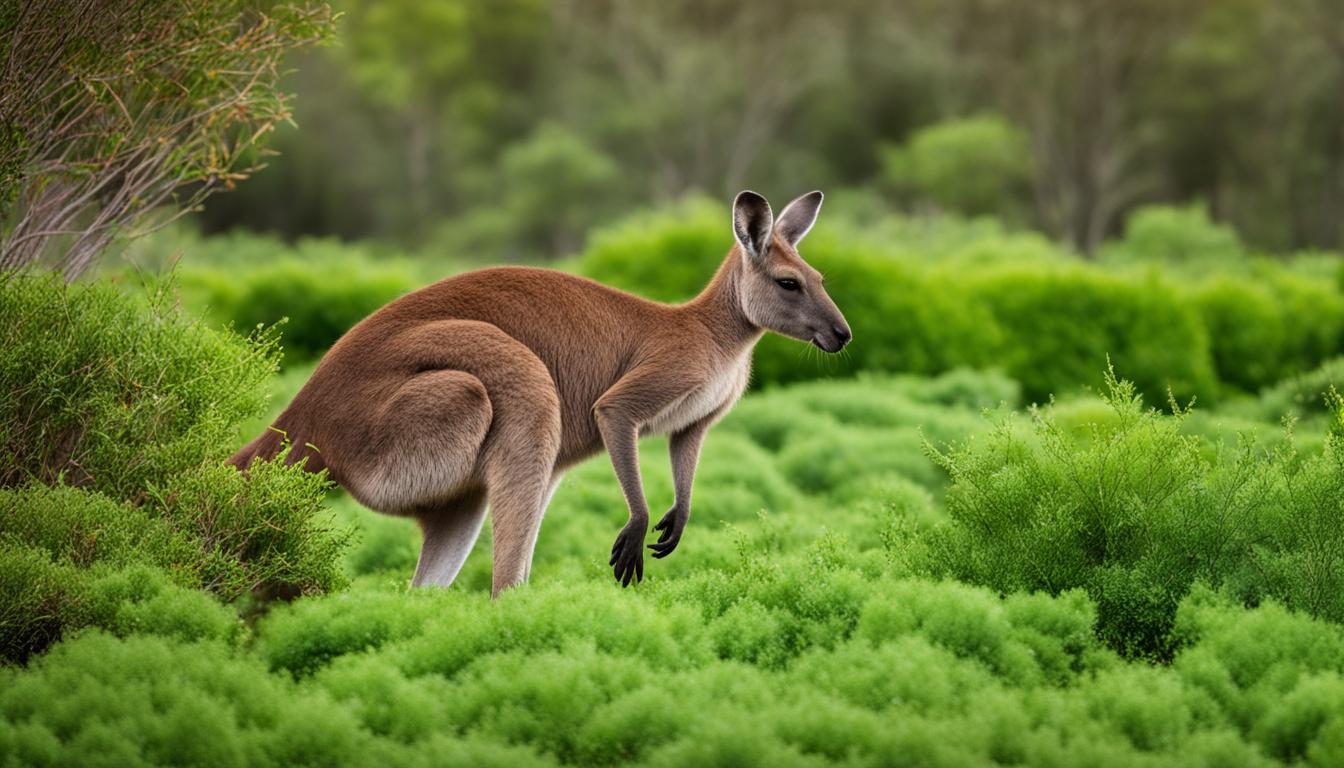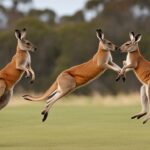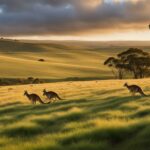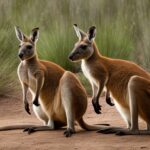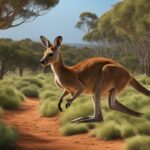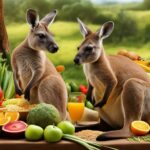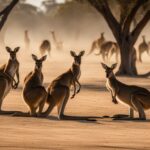Curious about the diet and feeding habits of kangaroos? You’ve come to the right place! Kangaroos are fascinating creatures that primarily feed on plants native to Australia. From fresh grass to flowering plants, mushrooms, ferns, and leaves, their diet is diverse and varied.
So, what do these hoppy herbivores munch on? Well, it depends on their species. Larger kangaroos, like the magnificent red kangaroo, have a preference for Australian grasses. On the other hand, smaller kangaroo species such as wallabies and quokkas enjoy nutrient-rich fruits, seeds, fresh shoots, mushrooms, and leaves.
Kangaroos have unique feeding behaviors too! Their teeth are specially adapted to their diets. Larger kangaroos have teeth designed to tear out grass with a quick head movement, while smaller kangaroos have teeth for cracking insects and small reptiles.
When it comes to finding food, kangaroos search for it in different habitats based on their size. Small kangaroos forage in the undergrowth of forests, while large kangaroos graze on open grasslands.
Kangaroos are primarily nocturnal animals, meaning they do most of their feeding from late afternoon until sunrise. But here’s an interesting fact: their specialized stomach allows them to efficiently ferment their food, so they can survive on less nutritious grasses during extreme conditions.
Remember, it’s important not to feed kangaroos in the wild. When we provide them with food, it can cause digestive issues and dependency on human-provided meals. Let’s respect their natural feeding habits and observe them from a safe distance.
Kangaroo Diet in the Wild
Kangaroos in the wild have a varied diet based on their habitat and the availability of different plant species. Their natural diet primarily consists of grasses, flowering plants, mushrooms, ferns, and leaves. Fresh green grasses are preferred by kangaroos as they are easier to digest and contain more nutrients compared to older dry grasses. Tall grasses are generally avoided, and kangaroos can survive on dry grasses during extreme situations. Additionally, depending on their species, kangaroos may consume salt-tolerant shrubs, acacia, and maireana.
Different kangaroo species have adapted to their specific diets, with unique tooth structures. Larger kangaroo species have front teeth that are specialized in tearing out grass, while smaller species have teeth to crack insects and small reptiles. Small kangaroo species like wallabies and quokkas have a more varied diet, including fruits, seeds, fresh shoots, and small invertebrates.
“Kangaroos in the wild primarily feed on grasses, but their diet also includes a variety of plants, mushrooms, and leaves. Their feeding behavior and food choices are influenced by their size, habitat, and the availability of different plant species.”
Weather conditions also play a significant role in the availability of food for kangaroos. During periods of drought, kangaroos may rely on less nutrient-rich and older plants to survive. It is important to note that while there have been rare observations of kangaroos consuming dead birds and fish, they do not typically eat meat as part of their natural diet.
Kangaroo Diet in the Wild – Summary
- Kangaroos primarily feed on grasses, flowering plants, mushrooms, ferns, and leaves in the wild.
- Fresh green grasses are preferred, while tall grasses are generally avoided.
- Smaller kangaroo species have a more varied diet, including fruits, seeds, fresh shoots, and small invertebrates.
- Availability of food is influenced by weather conditions, and kangaroos may rely on less nutrient-rich and older plants during droughts.
- Kangaroos do not typically eat meat, but there have been rare observations of them consuming dead birds and fish.
| Foods | Description |
|---|---|
| Grasses | Preferred food, contains more nutrients compared to older dry grasses |
| Flowering plants | Provide additional variety and nutrition to the diet |
| Mushrooms | Consumed for additional nutrients and variety |
| Ferns | Provide a source of nutrition and hydration |
| Leaves | Consumed as part of the overall plant-based diet |
Kangaroo Diet in Captivity
When it comes to the diet of kangaroos in captivity, a carefully managed approach is taken to ensure they receive the necessary nutrition for their well-being. Captive kangaroos are fed a balanced diet that consists of specially formulated pellets, which provide essential nutrients to meet their dietary requirements. Additionally, alfalfa hay, dandelion leaves, and a variety of fruits and vegetables are included in their diet plan.
The nutritional needs of kangaroos in captivity differ from those in the wild. Therefore, additional supplements may be given to captive kangaroos to ensure they receive all the necessary vitamins, minerals, and other essential nutrients. The goal is to mimic their natural diet as closely as possible while providing a well-rounded and complete nutritional profile.
It is important to note that the diet of captive kangaroos should only be handled by professionals who have a thorough understanding of their specific dietary needs. This ensures that the nutritional requirements are met and any potential health issues are properly addressed. Feeding kangaroos in captivity without proper knowledge can lead to health problems and malnutrition.
Kangaroo Feeding Habits and Behavior
Kangaroos have fascinating feeding habits and behaviors that are unique to their species. Understanding these habits can provide valuable insights into their natural diet and behavior patterns. Here, we explore the feeding habits, grazing behavior, and specialized teeth that enable kangaroos to survive in their native habitats.
Feeding Habits:
Kangaroos are predominantly grazers, spending a significant amount of time feeding on vegetation. They have adapted to their nocturnal lifestyle, feeding from late afternoon until sunrise. This allows them to avoid the heat of the day and conserve energy during periods of extreme temperatures. Kangaroos have a slow metabolism rate compared to smaller relatives like wallabies, allowing them to survive on fewer nutrients relative to their body weight.
Grazing Behavior:
When grazing, kangaroos use their specialized teeth to tear out grass with quick head movements. Larger kangaroo species have front teeth adapted to tearing out grass, while smaller species have teeth that can crack insects and small reptiles. Once the grass is torn out, kangaroos grind it with their molars for easier digestion. Their grazing behavior varies depending on their species and size, with large kangaroos typically grazing on open grasslands and smaller kangaroos foraging in the undergrowth of forests.

Specialized Teeth:
Kangaroos have unique tooth structures that have evolved to suit their specific diets. The larger kangaroo species have strong incisors and molars that are adapted to tearing out and grinding tough grasses. Smaller kangaroo species have teeth designed for cracking open insects and small reptiles. These adaptations allow kangaroos to efficiently consume the plant material and other food sources available to them in their natural habitats.
By understanding the feeding habits, grazing behavior, and specialized teeth of kangaroos, we gain a deeper appreciation for these remarkable creatures. These adaptations have enabled kangaroos to thrive in their native Australian landscapes, surviving on a variety of plant-based diets and utilizing their unique teeth to obtain the nutrients they need. Observing kangaroos in their natural habitat allows us to witness their feeding habits firsthand and better understand their role in the ecosystem.
Kangaroo Feeding and Human Interaction
Feeding kangaroos in the wild may seem like a fun and unique experience, but it is generally discouraged. While it’s understandable to be fascinated by these incredible animals, it’s important to consider the potential impact of feeding them. Kangaroos in the wild have specific dietary needs and are accustomed to finding their own food sources. Introducing human-provided food can lead to digestive issues and dependency on handouts, which can negatively affect their health.
Furthermore, certain human foods like bread can be harmful to kangaroos. Feeding kangaroos can also disrupt their natural feeding patterns and social dynamics. Competition for food may increase, leading to aggression among kangaroos. Additionally, human-provided food can attract other animals, which can cause conflicts and disrupt the ecosystem.
It is best to observe kangaroos from a safe distance and respect their natural diet and habitat. By doing so, you can appreciate their beauty and behavior without causing harm or disturbance. Remember, these incredible creatures have adapted over thousands of years to survive and thrive in their native environments. Let’s allow them to continue doing so by not interfering with their natural feeding habits and patterns.
| Impact of Feeding Kangaroos in the Wild | Solutions/Alternative Approaches |
|---|---|
| Can lead to digestive issues | Observe kangaroos from a safe distance |
| Dependency on human-provided food | Respect their natural diet and habitat |
| Disruption of natural feeding patterns | Do not introduce human-provided food |
| Increased competition and aggression among kangaroos | Understand and appreciate their natural behavior |
| Attraction of other animals, causing potential conflicts | Avoid disrupting the ecosystem |
Kangaroo Feeding Guidelines:
- Do not feed kangaroos in the wild
- Avoid introducing human-provided food
- Respect the natural feeding habits and patterns of kangaroos
- Observe kangaroos from a safe distance
- Do not approach or touch wild kangaroos
Conclusion
Kangaroos are fascinating creatures that primarily feed on plants native to Australia. Their diet varies depending on their species, with larger kangaroos mainly consuming grasses, while smaller species have a more varied diet. Kangaroos have unique feeding habits and behaviors, with specialized teeth that are adapted to their specific diets. They are predominantly active during the late evening and night, engaging in grazing as their primary feeding activity.
Feeding kangaroos in the wild is not recommended, as it can have negative impacts on their health, behavior, and natural feeding patterns. When kangaroos are fed by humans, it can lead to digestive issues and dependency on handouts. Certain human foods, such as bread, can also be harmful to kangaroos. Additionally, feeding kangaroos can disrupt their natural social dynamics and attract other animals, causing potential conflicts and disturbances in the ecosystem. It is best to observe these magnificent creatures from a safe distance and respect their natural diet and habitat.
By appreciating kangaroos in their natural environment and refraining from feeding them, we can ensure their well-being and contribute to the preservation of their species. Remember to always be mindful of their unique dietary needs and maintain a respectful distance when observing them. Let’s work together to protect these incredible herbivores and the delicate balance of their native habitats.
Are There Any Safe Alternatives to a Kangaroo’s Typical Diet?
Many experts believe that it’s possible to find safe alternatives to kangaroos’ dietary habits. While kangaroos typically consume grasses and other vegetation, it’s important to consider their nutritional needs when exploring alternative food sources. With careful consideration, it’s possible to find suitable alternatives that meet their dietary requirements.
FAQ
What do kangaroos typically eat?
Kangaroos are primarily herbivores and feed on plants native to Australia. They have a preference for fresh grass, but also consume flowering plants, mushrooms, ferns, and leaves.
Do kangaroos eat meat?
Kangaroos are not known to eat meat, but there have been rare observations of kangaroos consuming dead birds and fish.
How do kangaroos feed?
Larger kangaroo species tear out grass with a quick head movement and grind it with their molars, while smaller kangaroos have teeth to crack insects and small reptiles.
What is the feeding behavior of kangaroos?
Kangaroos typically feed from late afternoon until sunrise. They are nocturnal animals and have a specialized stomach that allows them to efficiently ferment their food.
Can I feed kangaroos in the wild?
Feeding kangaroos in the wild is not recommended, as it can lead to digestive issues and dependency on human-provided food. It can also disrupt their natural feeding patterns and social dynamics.

